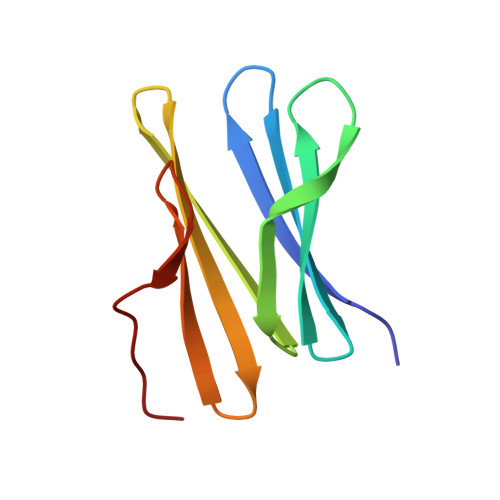The Fucose-Binding Lectin from Ralstonia Solanacearum: A New Type of {Beta}-Propeller Architecture Formed by Oligomerization and Interacting with Fucoside, Fucosyllactose, and Plant Xyloglucan.
Kostlanova, N., Mitchell, E.P., Lortat-Jacob, H., Oscarson, S., Lahmann, M., Gilboa-Garber, N., Chambat, G., Wimmerova, M., Imberty, A.(2005) J Biological Chem 280: 27839
- PubMed: 15923179
- DOI: https://doi.org/10.1074/jbc.M505184200
- Primary Citation of Related Structures:
2BS5, 2BS6, 2BT9 - PubMed Abstract:
Plant pathogens, like animal ones, use protein-carbohydrate interactions in their strategy for host recognition, attachment, and invasion. The bacterium Ralstonia solanacearum, which is distributed worldwide and causes lethal wilt in many agricultural crops, was shown to produce a potent L-fucose-binding lectin, R. solanacearum lectin, a small protein of 90 amino acids with a tandem repeat in its amino acid sequence. In the present study, surface plasmon resonance experiments conducted on a series of oligosaccharides show a preference for binding to alphaFuc1-2Gal and alphaFuc1-6Gal epitopes. Titration microcalorimetry demonstrates the presence of two binding sites per monomer and an unusually high affinity of the lectin for alphaFuc1-2Gal-containing oligosaccharides (KD = 2.5 x 10(-7) M for 2-fucosyllactose). R. solanacearum lectin has been crystallized with a methyl derivative of fucose and with the highest affinity ligand, 2-fucosyllactose. X-ray crystal structures, the one with alpha-methyl-fucoside being at ultrahigh resolution, reveal that each monomer consists of two small four-stranded anti-parallel beta-sheets. Trimerization through a 3-fold or pseudo-3-fold axis generates a six-bladed beta-propeller architecture, very similar to that previously described for the fungal lectin of Aleuria aurantia. This is the first report of a beta-propeller formed by oligomerization and not by sequential domains. Each monomer presents two fucose binding sites, resulting in six symmetrically arranged sugar binding sites for the beta-propeller. Crystals were also obtained for a mutated lectin complexed with a fragment of xyloglucan, a fucosylated polysaccharide from the primary cell wall of plants, which may be the biological target of the lectin.
- National Centre for Biomolecular Research and Department of Biochemistry, Masaryk University, Brno 611 37, Czech Republic.
Organizational Affiliation:



















